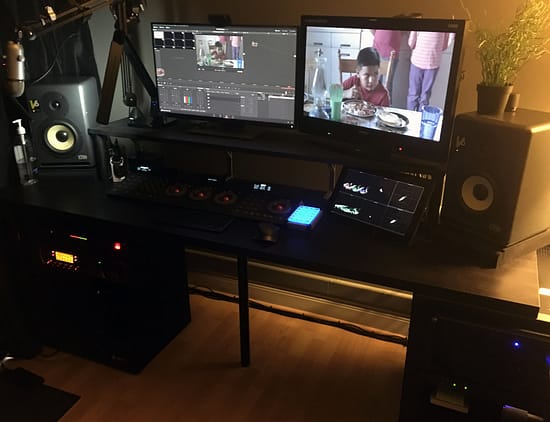Two Readily Available Technologies Improved My Life & Let Me Get More Done
You’ve probably heard the adage – ‘not enough time in the day’.
Look up this phrase on the Internet and you might just read in the explanation ‘see Robbie Carman & other colorists’.
Joking aside, I’m lucky enough to be a very busy colorist with a loyal client base that always seems to have a project ready for me to work on.
Even though that sounds awesome (and it is), the downside is that I’m stuck at the office – ALL THE TIME.
It’s my own doing, but I typically work 12-hour color grading days + other responsibilities like training, speaking and oh yeah, being a husband & father to two beautiful, smart, creative kids.
While everyone I know (especially Dan/Pat) tell me I work too much and have a long list of ways to lessen the load, it’s the husband & father part that weighs heavy on me.
Sure, grading awesome projects, keeping clients happy and earning more business are important things, but it’s not a hard argument to make that family is most (and more) important.
For the past year, I’ve been slowly building out the capabilities of my home setup to be equal or near equal to my facility setup – with the goal to work more from home when I’m not supervised AND to be able to get home at a consistent hour to help my kids with homework, read bedtime stories, and maybe even talk to my wife for a bit 🙂
In this Insight, I briefly want to share some details about my setup at home and then discuss two things that allowed me to have a seamless workflow from the office to home without exporting projects or shuttling drives back and forth.
The Home Studio
For years, I’ve been depending on an iMac at home. They’re AWESOME machines.
The 5k 27in iMac is really a fantastic machine. But after attempting to use it as an alternative to my main work setup (yeah, I know that I’m a year or so late on that part!) it just fell flat on its face.
Real-time NR performance? Yeah right, it’s a mobile GPU.
RAW performance? Not great even with an i7. The best parts of the 27″ iMac are the screen, the all-in-oneness and of course the familiarity and ease of use of Mac OS.
Having spent a year or so with Windows and Linux at the office, I decided that I needed to step up my game at home, and after a cursory thought about a ‘new’ Mac Pro I just couldn’t justify 10k on a system that is currently using 3+ year old CPUs and often problematic GPUs.
Our audio team lead by partner Cheryl Ottenritter , invested heavily in systems from ADK, and has been ridiculously happy with them.
ADK is a PC system builder focusing on the audio and pro video markets. Bang for the buck they were hard to beat. With that said, while they’re able to build systems that are often thousands less than HP, Dell, and others they’re using off the shelf components.
One reason you pay more for an HP, Dell or Supermicro system is the R&D that goes into building those systems.
ADK builds are no frills – meaning you’ll have to use a screwdriver for a lot of things. The designs aren’t revolutionary or even sexy.
To me, those things simply don’t matter – I wanted a robust system, cheaper than I could get from the main PC builders. I’ve been very impressed with the build that I got.

Here are the highlights:
- Asus X99-WS USB 3.1 Motherboard
- Single 14 Core 2.6ghz Xeon
- Full Rackmount Case (27in deep, yikes but fans are quite)
- 128GB Ram
- 2X Titan X
- Asus Thunderbolt 2 PCI card
- Blu-Ray Burner
- 2 TB Samsung 850 Pro System Drive
- 2 x 2TB Samsung 850 Pro (Raid 0) Render Cache Drives
- Decklink SDI 4k
- Atto R680 Raid Controller (taken from office machine)
- Sonnett SAS RAID 8×3 TB (also taken from office machine)
- Drobo 5D – Backup (5x3TB + M2 Card)
Other items in my home studio build include:
- Tangent Element (all four panels)
- X-keys 21 key unit
- FSI CM250
- Cinemaquest Ideal-Lume Bias Light
- i7 Mac Mini (Scopebox & Plex Server!)
- Dell Ultrasharp 2716D 27in monitor
- GeChic 13″ touch screen monitor for Mac Mini (scopes/Plex)
- KRK V6 studio monitors – yep, they’re old, but I love ’em
- Blue Yeti with Rode Boom Arm
- Anker Studio Light
- Avid Rack Eleven (gotta rock)
- Logitech MX Master Mouse (amazing mouse) and K810 Bluetooth Keyboard
I’m very happy with this system. Admittedly, I know this is not a typical ‘home’ system. I sunk quite a bit of money and time into the build, but my goal was always to replicate what I work on day to day at the office.
Now that you know what I’m working with let’s dive into the difference makers of this setup.
A Few Words About PostGres SQL
I know many of you depend on disk databases. If you’re a Resolve (non-studio) user you have to as there is no support for shared PostGres SQL databases.
In my facility, we rely on PostgresSQL databases for a few reasons:
First, you can share them – get the same database in any room and that ability is the heart of this Insight. The details in this Insight DO NOT APPLY to sharing Disk Databases.
Next, PostGresSQL databases unlock Resolve’s collaborative features including remote rendering.
Before you continue, there is some required reading/watching here on mixinglight.com.
First is Dan’s approach to setting up a shared SQL database HERE. I produced an article showing my approach to the shared database HERE, and most importantly, Dan wrote a great article on automated SQL database backup HERE.
I would like to also raise three red flags about SQL databases:
- Everything I describe below about setting up and working with VPN and shared databases assumes a Mac Postgres Database Server. I have no experience setting this up on Linux (should be similar) or Windows (no idea),
- Some other applications namely the Mac OS X server app also install (sometimes a newer version) Postgres. I can’t say it strongly enough USE ONE MACHINE FOR A RESOLVE SQL DATABASE SERVER, ANOTHER FOR WEB SERVICES INCLUDING VPN.
- For the love of all that is holy, please backup your SQL databases – manually or with Dan’s script detailed in his Insight. Since SQL databases are not something you ‘see’ compared to disk databases, it’s easy to forget about them.
PostRes SQL is awesome with Resolve, but it takes some extra attention.
The Need For Speed
Who doesn’t love fast Internet?
One of the most crucial parts of my setup is fast Internet – both for VPN but most importantly for Sync (BitTorrent Sync) file sharing.
I live about a block from a Verizon Fios head-end and I can get 300/300 mbps speeds (they offer 500/500 but it’s stupidly expensive).
In my testing, the threshold for the workflow I describe below is much lower, and it’s all about download speed which is the higher number in most Internet plans.
I think 50/25 or similar is a good base level.
Of course, if faster Internet is available, jump on it as your budget allows.
Member Content
Sorry... the rest of this content is for members only. You'll need to login or Join Now to continue (we hope you do!).
Need more information about our memberships? Click to learn more.
Membership optionsMember Login


